#Mound Key Calusa
Text
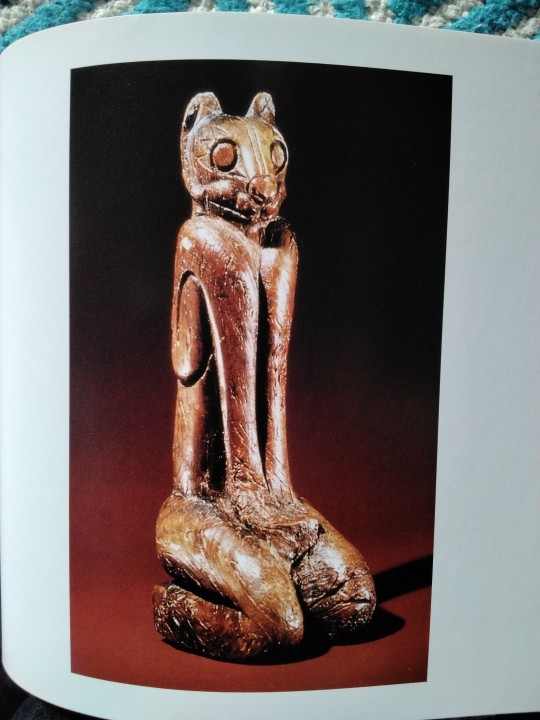
Key Marco cat, c.1600s.
Region: Florida.
This tribal representation of a kneeling cougar was part of an extraordinary archaeological find on Marco Island in 1896. This area of south-west Florida was originally populated by the Calusa Indians – hunter-gatherers who are known to have been fierce warriors. They fished in the estuaries and have been dubbed ‘The Shell People’ because of the great mounds of shells that have also been found here. They were scattered and disappeared soon after the Spanish explorers came to the area.
The Calusa were skilled artisans, and more than 1,000 pieces were discovered at the Key Marco site at the northern tip of the island, including masks and weapons, ceramics, bone and shell artefacts, some of which date back to the sixth century CE. The site was discovered by Captain W. D. Collier and excavated by Frank Hamilton Cushing. Dating from the seventeenth century, the cat is about 15cm (6 in) high and is in remarkably good condition. It is carved from wood and represents a feline/human figure. The anaerobic properties of the mud had preserved it for centuries.
Source: ‘Folk Art’, Susann Linn-Williams, pp. 154-55.
#Native American#traditional crafts#Marco Island#Florida#Calusa tribe#The Shell People#shells#Captain W D Collier#Frank Hamilton Cushing#folk art
3 notes
·
View notes
Text
In Search of the Calusa 2
In Search of the Calusa 2
-Ed, Estero Bay, Lee County, FLIn Search of the Calusa 2-Mound Key to Marco Island, May 8-13, 2022.
In Calusa 1, Ed, Mindi, and I learned about villages of the Calusa that once existed right in downtown, Ft Meyers. Soon after, we visited an even more remarkable remnant, the Mound House seven miles away on Ft Meyers Beach.
Continuing our journey, we headed south along Estero Bay, an aquatic…
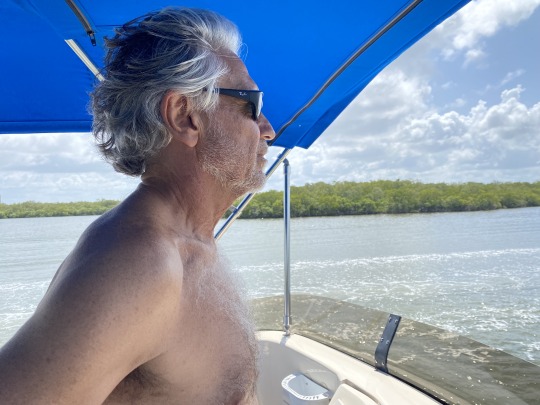
View On WordPress
#Archeological history Key Marco Cat#artifact replicas Calusa#Austin Bell#Calusa artifacts#Calusa culture#Calusa history made easy#Calusa Indians#Cushing#Estero Bay#Frank H. Cushing#In Search of the Calusa 2#Marco Cat#Marco Key#Mound Key#Mound Key Calusa#Mound Key capital#Old Marco Inn#Panther Man God#W.D. Captain Bill Collier#Wells M. Sawyer
0 notes
Text
Archaeologists verify Florida's Mound Key as location of elusive Spanish fort

Florida and Georgia archaeologists have discovered the location of Fort San Antón de Carlos, home of one of the first Jesuit missions in North America. The Spanish fort was built in 1566 in the capital of the Calusa, the most powerful Native American tribe in the region, on present-day Mound Key in the center of Estero Bay on Florida's Gulf Coast.
Archaeologists and historians have long suspected that the fort, named for the Catholic patron saint of lost things, was located on Mound Key. Researchers have been searching for concrete evidence in the area since 2013.
"Before our work, the only information we had was from Spanish documents, which suggested that the Calusa capital was on Mound Key and that Fort San Antón de Carlos was there, too," said William Marquardt, curator emeritus of South Florida archaeology and ethnography at the Florida Museum of Natural History. "Archaeologists and historians had visited the site and collected pottery from the surface, but until we found physical evidence of the Calusa king's house and the fort, we could not be absolutely certain." Read more.
158 notes
·
View notes
Text
Pre-contact Native American Cities
There were a number of large population centers in the Americas. I will be focusing on those in what is now the US and Canada, but large cities also existed south of the Rio Grande.
Generally considered the greatest pre-Columbian Native American city, Cahokia once sat directly across the river from what is now St. Louis, Missouri. It was settled around 600 CE and existed from 1050-1350 CE, with its apex around 1100 CE. Cahokia likely had more than 20,000 people living in (thousands more than London, at the time) and was the most influential urban settlement of the Mississippian culture.
Cahokia, on the Mississippi River, was an important center for trade and agriculture. It maintained trade links with communities from the Great Lakes to the Gulf Coast and had people living outside the main urban center. Cahokia, and the Mississippians who built it, were known for their incredible urban planning and the mounds that made up the city center. Today, the Cahokia Mounds are a UNESCO World Heritage site.
Second, the Poverty Point (named after a 19th-century plantation on top of it) culture was centralized in what is now northeastern Louisiana. Like Cahokia, it had a number of important mounds for urban life. It was constructed over multiple generations, and radiocarbon dating suggests that earthwork construction was in progress from 1800-1200 BCE. Poverty Point is one of the most ancient cities in the Americas. Poverty Point had a rich material culture include fired earthware, copperwork, and stone vessels. They had manufacturing and long-distance trade.
Third, the Calusa (Caloosahatchee) people of the southwest coast of Florida, on the coast of the Gulf. They also built mounds and, at the time of European contact in the 16th century, had a population in the 10,000s. They were likely the only indigenous North Americans who established a kingdom without practicing agriculture, using the abundant fishing resources instead. The main mound, Mound Key, was a manmade structure with canals, watercourts, and other features. The Calusa were notable for their carved-wood art and their sophisticated engineering and architecture. A single manor on Mound Key was capable of holding 2,000 people.
Fourth, the Mogollon culture was one of the major cultures of southwest America. It had multiple large and dense settlements, but one that's considered a proper city. Called Paquimé, it was settled from 1130-1450 CE. It had a population in the thousands, who lived in multi-story buildings and an irrigation-based agricultural economy. They had a complex system of water control that included drainage, reservoirs, channels, and sewage. The city had a market, ballcourts, and the production of copper and ceramic objects.
The final city to discuss is Etzanoa. Located in what is now Arkansas City, Kansas on the Arkansas River, it actually flourished after and alongside European contact, mostly with the Spanish. Etzanoa housed approximately 20,000 people. It was a seat of power for the Wichita and a trading hub.

[Image Description: A black and white map of the United States. States are outlined but not labeled. Five stars mark the location of cities. Cahokia is on the border of Arkansas and Illinois. Etzanoa is on the border of Kansas and Oklahoma. Poverty Point is on the border of Louisiana and Mississippi. Mound Key is in southern Florida. Paquimé is slightly below New Mexico.
#history#world history#national native american heritage month#native american history#indigenous history#history they didn't teach you in school#pueblo#cahokia#caddo#calusa#mogollon#etzanoa#wichita#poverty point#map#ancient#antiquity#urban planning#urban design#ancient civilizations
46 notes
·
View notes
Link
Beginning roughly 2,000 years ago, the Calusa enjoyed centuries of dominance as the undisputed rulers of southwest Florida. Theirs was a complex society with trade routes spanning hundreds of miles; a powerful military; and built works including wide canals, islands made of shells and towering buildings.
Unlike the Maya, Aztecs and Inca, the Calusa built their kingdom, which stretched from modern Tampa Bay to Ten Thousand Islands and as far east as Lake Okeechobee, without agriculture.
Researchers have long wondered how a society that collected all of its food by fishing, hunting and gathering was able to secure enough food to support its ambitious construction projects and military might. Now, a new study published in the Proceedings of the National Academy of Sciences reveals details of how the Calusa stockpiled live fish in massive holding pens, or “watercourts,” built out of oyster shells. The idea that these watercourts held fish is not new, writes George Dvorsky for Gizmodo, but the paper is the first to conduct a systematic analysis of the ancient structures.
The remains of these watercourts—the largest of which is seven times larger than an NBA basketball court—are located near Fort Myers in Mound Key, where the Calusa’s capital city of Calos stood for 500 years.
Mound Key is quite an accomplishment in and of itself. A human-constructed island made primarily of shells, the island’s building materials, by volume, could fill 200 Olympic swimming pools, Victor Thompson, lead author of the new study and an anthropologist at the University of Georgia, tells Haaretz’s Ruth Schuster. The Great Pyramid of Giza is made of roughly 1,000 swimming pools worth of stone, but as Thompson points out, “The ancient Egyptians didn’t eat the stones before they built it.”
The watercourts flanked a 100-foot-wide canal that bisected the entire island. Each one had a roughly six-foot-long opening onto the canal. The researchers speculate that this feature may have been used to drive fish into the pens before sealing them inside with a gate.

Atop a 30-foot-high shell mound, the Calusa constructed an expansive manor capable of holding 2,000 people, according to Spanish records. Fish stored in Mound Key’s watercourts may have provided the food resources needed to complete the project. (Florida Museum / Illustration by Merald Clark)
For the new study, researchers analyzed two watercourts to determine when and how they were built, how they worked, and whether their appearance mirrored other significant developments in the Calusa kingdom. The team used core samples, excavated fish bones, radiocarbon dating and remote sensing to probe the watercourts for answers.
Radiocarbon dating placed the construction of the watercourts between 1300 and 1400 A.D. This timeframe coincided with the second phase of construction of Calusa king Caalus’ manor—a massive building that could hold 2,000 people at the time of its completion, according to Spanish documents.
The watercourts could also have been an innovation prompted by a drop in sea level that occurred around 1250, potentially impacting “fish populations enough to help inspire some engineering innovation,” says Karen Walker, study co-author and an archaeologist at the Florida Museum, in a statement.
Bones and scales excavated from the ancient holding pens belonged to mullet, pinfish and herring, all schooling species that might have been easily herded inside.
Remote sensing yielded a 3-D map of the island’s surface that features what appear to be ramps leading from the watercourts to two shell mounds—perhaps facilitating the transport of food.
Excavations found ancient ash and other evidence pointing toward the presence of racks for drying and smoking fish, according to the statement. And core samples from the watercourts contained a layer of dark gray sediment that appears to be on par with ancient pond scum. The researchers say this suggests the water inside of the structures did not circulate much, and that the walls were tall enough not to get flooded by high tide.
“We can’t know exactly how the courts worked,” says Michael Savarese, study co-author and a geologist from Florida Gulf Coast University, in the statement. “But our gut feeling is that storage would have been short-term—on the order of hours to a few days, not for months at a time.”
The Calusa built their entire way of life around the ocean and estuaries of the Gulf Coast, creating a vast empire by learning to manipulate their environment. Though eschewing agriculture once led some researchers to assume that the Calusa were less sophisticated, it also made them innovative and unique.
“The fact that the Calusa obtained much of their food from the estuaries structured almost every aspect of their lives,” says Thompson in the statement. “Even today, people who live along coasts are a little different, and their lives continue to be influenced by the water—be it in the food they eat or the storms that roll in on summer afternoons in Southwest Florida.”
481 notes
·
View notes
Text
Journal 7
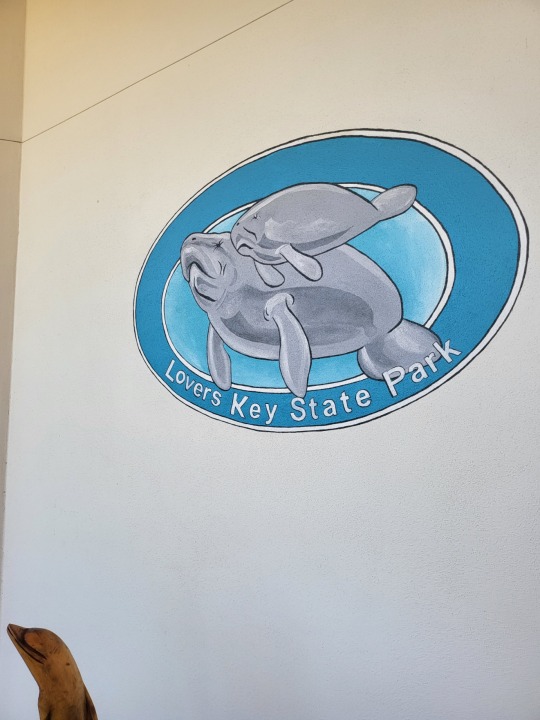
Lovers Key State Park is an estuary. An estuary is an environment where fresh water mixes with salt water. Small fish will seek shelter in estuaries to lay their eggs, and birds like to create their nests in estuaries. Lovers Key State Park also consists of four islands. The islands are called Inner Key, Long Key, Black Island, and Lovers Key. Black Island got its name from a pirate called Black Augustus. While Black August was running from the authorities, he successfully evaded them by hiding on the island. Lovers Key got its name because before their were any bridges to the island, couples would take boats their for a romantic private getaway.
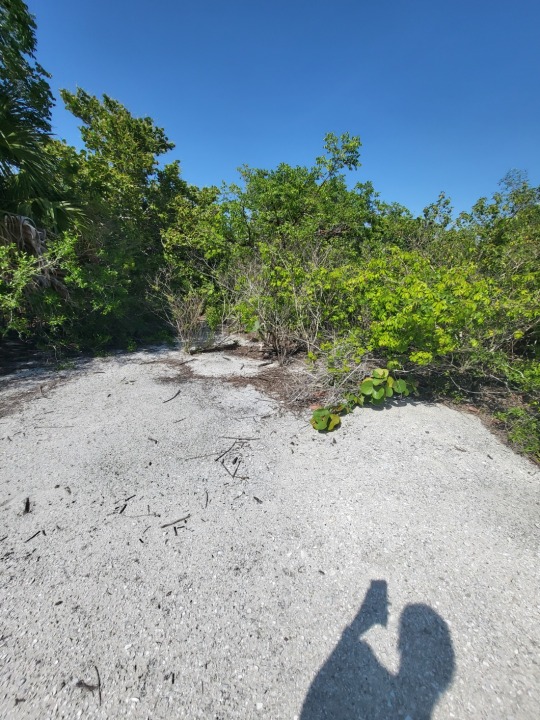
Black Island starts off as a tropical hammock ecosystem. This type of ecosystem allows plants to be able to grow closer to the water. For a lot of these plants, if they did not have the shade that the tropical hammock provides, then they would not be able to grow on the island. It also consists of a group of plants called antisocial plants. One example of an antisocial plant is a Spanish Bayonet. Antisocial plants are unique because they are covered in spikes that prevent pests from being able to eat their leaves.
As you walk along Black Island, the ecosystem shifts into a coastal shrub ecosystem. This was created when the island was dredged. When it was dredged, all of the sand was piled together, and it raised the elevation of the island, which in turn, changes the ecosystem. When the island was dredged, it was also deigned to be a replica shell mound. In particular, it is meant to resemble a Calusa Shell Mound. Shell mounds are important because they protect the inland from flooding.

Black Island is also covered by mangroves. Mangroves are important because their long roots provide shelter for many different types of animals. For example, fish will hide among the roots to prevent preying birds from swooping down and grabbing them. Black Island has all three types of mangroves, black mangroves, red mangroves, and white mangroves. Black mangroves can be found closest to the water, while white mangroves are the farthest away from water. Black Island is also covered in strangler fig trees. Strangler fig trees are unique because their seeds attach themselves to the middle of another tree, and then will grow in both directions. Luckily, they do not harm the tree they attach themselves too.
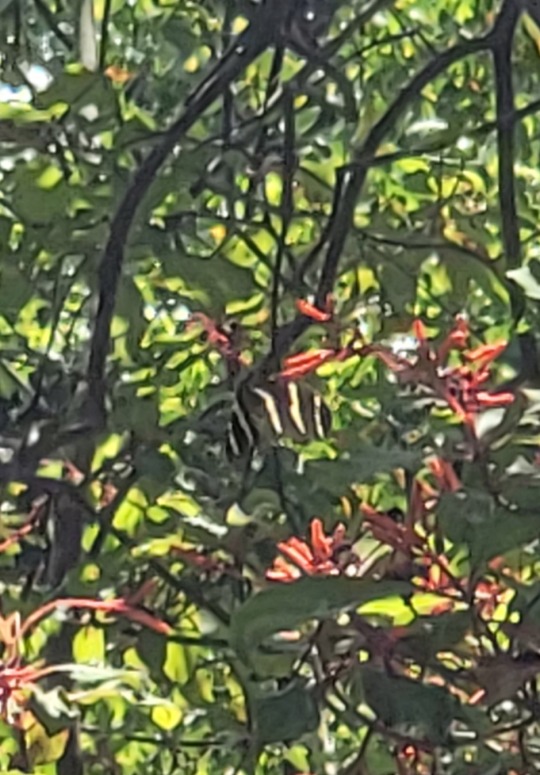
Black Island is also home to a butterfly garden. The plants in the garden is all native plants, and I saw many different species of butterflies while I was walking through it. This is a good sign because butterflies are an indicator of a healthy environment. One of the butterflies that I saw was a Zebra Butterfly. These butterflies can be identified by their black wings with yellow stripes. This was very special to me because the Zebra Butterfly is Florida's state butterfly. I have been developing a real sense of place in Florida since I moved here, and it felt really good to have the state butterfly around me.

I also spotted a Gulf Fritillary while walking around the butterfly garden. These can be identified by their red and orange wings with spots all over. Orange has always been my favorite color, so I immediately was attracted to the Gulf Fritillary. Orange butterflies are also the first thing I think of when I think of a butterfly.
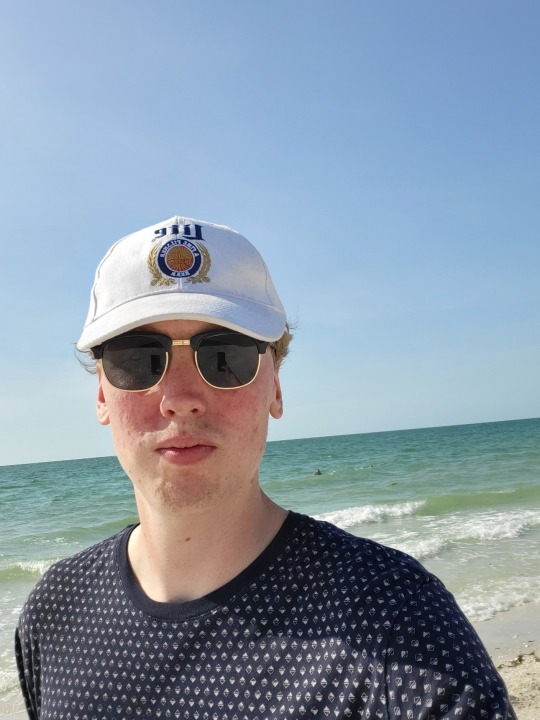
The main beach on the state park is located on Lovers Key. Beach habitats are important because they protect the inland from erosion. They are also good for the areas economy. Beaches, in particular Florida's beaches, attract tourists from all over. If the beaches start to degrade or become filed with trash, people will stop wanting to visit, and Florida's economy could crash.
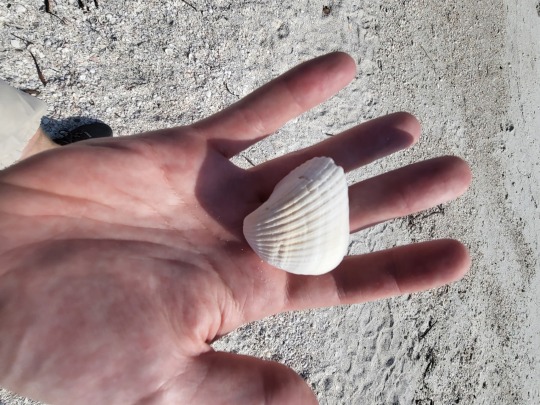
Walking along the beach, I spotted many different kinds of shells. One type of shell that I saw was the Cockle Shell. This shell is unique because they usually will take the shape of a heart. They also thrive on sandy beaches. This was special for me to find because I remember always collecting Cockle Shells whenever I visited Florida beaches as a child.
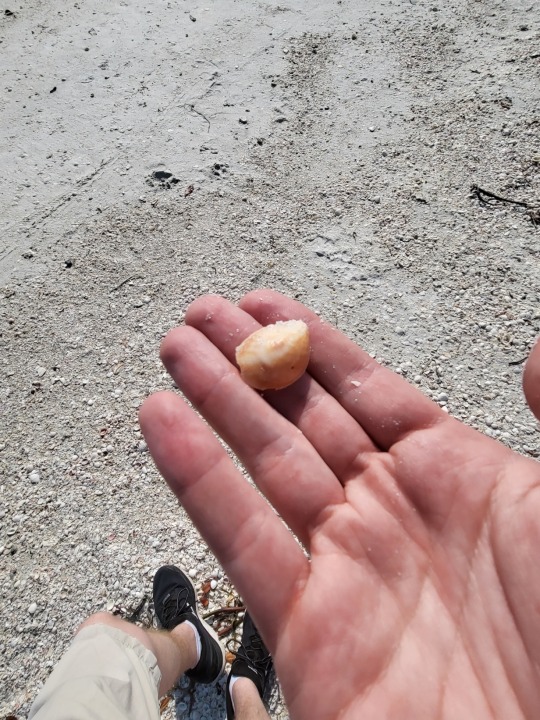
I also found many pieces of from conch shells. Conch shells are very common to Florida beaches, but they usually break apart while they are being washed onshore. These are special to me for a couple multiple different reasons. Conch shells are bright orange, and they are also Florida's state shell. Additionally, whenever I see one, it always reminds me of the time I actually found a completely intact one when I came to the beach with my mom.
Photo Credit: All of the photos in this post were taken by Bradley Hoberman.
0 notes
Text
Mike Anzivino - Get Your Dream Property At Fort Myers
Fort Myers is a small seaside town with a small-town atmosphere. The traffic is heavy, the pace is slow, and the sunset will knock your socks off!
The city provides something for everyone, whether you've come for a vacation, a career, or just to visit and enjoy a fantastic seafood supper. Boredom is not an option when it comes to visiting interesting historical sites or engaging in thrilling family outdoor activities.
Who knows, maybe the beauty and carefree way of life may compel you to hunt for a Fort Myers apartment and make this city your temporary home. This city is ideal for those who work from home.
So, remain with us, because the purpose of this piece is to assist you in discovering the top things to see and do in Ft. Myers, FL.
The area's sandy beaches are, of course, one of its main draws. The following are some of the most popular beach activities:
Seafarers here enjoy collecting shells as a hobby. Beautiful shells can be found on Fort Myers Beach and just south of Bonita Beach. If you want to jump on an island, the islands of Sanibel and Captiva are great places to start!
Kayaking and paddleboarding are excellent ways to walk on water or play volleyball on some of Florida's softest sands. If you enjoy doing a lot of traveling throughout the world, hop on your bike and head to the Fort Myers waterfront for some shopping and dining.
The Farmers Market Restaurant, which serves breakfast and lunch, has been helping sailors get off to a good start since 1952. Grits, biscuits and gravy, eggs cooked to order, and other southern breakfast favourites are available until 10:30 a.m.
If you're looking for something to eat for lunch, they have an excellent assortment of sandwiches, salads, and burgers, but locals will tell you that what makes it unique is where it's located! In the south, you'll discover luxury meals like meatloaf, fried fish, and shrimp, and grits, which are ideal fuel for an afternoon sleep.
This is the ideal location for a date! The Veranda, one of Fort Myers' greatest restaurants, is housed in two totally renovated buildings with outdoor garden courtyards that have been renovated for a century.
It's not all beaches and cuisine in Fort Meyers! It also has a plethora of cultural centres and historical locations where visitors may spend the day learning about the area and its inhabitants.
The Calusa has thrived as indigenous of south-eastern Florida and Ft. Myers for more than 2,000 years. Calusa's remains were discovered in the Mound House and Mound Key Archaeological State Park regions.
Both give lovely tours that highlight the natural beauty of what was formerly Calusa's home as well as some of the art artifacts discovered there that brighten their daily lives.
It's not just the beaches and sunshine that make Fort Myers such a wonderful location to visit. The locals are also friendly and eager to welcome visitors from all over the world to their lovely city.
So, whether you're a local or like to spend your time at the stores and restaurants, we hope you've provided us with some fun activities. The only issue is picking which task to tackle first!
Mike Anzivino – Fort Myers realtor has offices all around Southwest Florida, so no matter where you go, you'll be able to use our technologies. Because they are also locals and share life in Southwest Florida, our Fort Myers shopkeepers are familiar with the local retail market. We've prepared you with a unique approach to assisting you in finding your ideal property.
Our local knowledge benefits real estate owners looking to sell a condo or house, and we are dedicated to ensuring that the correct purchasers see your property. Buyers will get the finest possible view of photographs, text, maps, and data about your site. For retailers, we offer Comparable Market Analysis, which provides you with a global perspective backed by our proprietary technology.
Whether you're buying or selling a home in Southwest Florida, we're dedicated to making you the most money possible. To learn more about how our team can improve your real estate experience, contact our Realtors specialists or obtain a free catalogue.
0 notes
Text
GET YOUR DREAM PROPERTY AT FORT MYERS– CONTACT MIKE ANZIVINO NOW!
Home For Sale Fort Myers
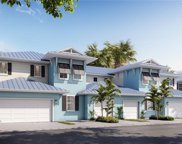

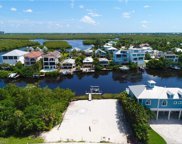
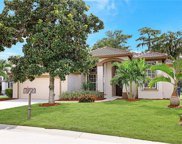
Fort Myers is a small seaside town with a small-town atmosphere. The traffic is heavy, the pace is slow, and the sunset will knock your socks off!
The city provides something for everyone, whether you've come for a vacation, a career, or just to visit and enjoy a fantastic seafood supper. Boredom is not an option when it comes to visiting interesting historical sites or engaging in thrilling family outdoor activities.
Who knows, maybe the beauty and carefree way of life may compel you to hunt for a Fort Myers apartment and make this city your temporary home. This city is ideal for those who work from home.
So, remain with us, because the purpose of this piece is to assist you in discovering the top things to see and do in Ft. Myers, FL.
The area's sandy beaches are, of course, one of its main draws. The following are some of the most popular beach activities:
Seafarers here enjoy collecting shells as a hobby. Beautiful shells can be found on Fort Myers Beach and just south of Bonita Beach. If you want to jump on an island, the islands of Sanibel and Captiva are great places to start!
Kayaking and paddleboarding are excellent ways to walk on water or play volleyball on some of Florida's softest sands. If you enjoy doing a lot of traveling throughout the world, hop on your bike and head to the Fort Myers waterfront for some shopping and dining.
The Farmers Market Restaurant, which serves breakfast and lunch, has been helping sailors get off to a good start since 1952. Grits, biscuits and gravy, eggs cooked to order, and other southern breakfast favourites are available until 10:30 a.m.
If you're looking for something to eat for lunch, they have an excellent assortment of sandwiches, salads, and burgers, but locals will tell you that what makes it unique is where it's located! In the south, you'll discover luxury meals like meatloaf, fried fish, and shrimp, and grits, which are ideal fuel for an afternoon sleep.
This is the ideal location for a date! The Veranda, one of Fort Myers' greatest restaurants, is housed in two totally renovated buildings with outdoor garden courtyards that have been renovated for a century.
It's not all beaches and cuisine in Fort Meyers! It also has a plethora of cultural centres and historical locations where visitors may spend the day learning about the area and its inhabitants.
The Calusa has thrived as indigenous of south-eastern Florida and Ft. Myers for more than 2,000 years. Calusa's remains were discovered in the Mound House and Mound Key Archaeological State Park regions.
Both give lovely tours that highlight the natural beauty of what was formerly Calusa's home as well as some of the art artifacts discovered there that brighten their daily lives.
It's not just the beaches and sunshine that make Fort Myers such a wonderful location to visit. The locals are also friendly and eager to welcome visitors from all over the world to their lovely city.
So, whether you're a local or like to spend your time at the stores and restaurants, we hope you've provided us with some fun activities. The only issue is picking which task to tackle first!
Mike Anzivino – Fort Myers realtor has offices all around Southwest Florida, so no matter where you go, you'll be able to use our technologies. Because they are also locals and share life in Southwest Florida, our Fort Myers shopkeepers are familiar with the local retail market. We've prepared you with a unique approach to assisting you in finding your ideal property.
Our local knowledge benefits real estate owners looking to sell a condo or house, and we are dedicated to ensuring that the correct purchasers see your property. Buyers will get the finest possible view of photographs, text, maps, and data about your site. For retailers, we offer Comparable Market Analysis, which provides you with a global perspective backed by our proprietary technology.
Whether you're buying or selling a home in Southwest Florida, we're dedicated to making you the most money possible. To learn more about how our team can improve your real estate experience, contact our Realtors specialists or obtain a free catalogue.
0 notes
Text

June 15, 2018
Ancient Native American King's House Rediscovered in Florida
Spanish troops met a great Calusa leader at Mound Key, Florida in 1566. The king lived in a structure that could host 2000 individuals. The Calusa created a non-agricultural complex society based on fishing, hunting, and gathering. They ate sharks, turtles, shellfish, mullet, deer, birds, wild produce, and animals from the coasts, estuaries and mangrove forests. They grew chili peppers, papaya, and gourds in home gardens.
They developed a priesthood, military, canals, extensive trade routes, and tribute gathered from 20,000 people. Mound Key was an artificial island made from oysters and clam shells, topped with the huge royal house. The Spanish were forced to withdraw from the area after three years due to unending hostility. The Calusa burned down Mound Key. The Spanish did not return for another century. But Spanish diseases decimated their population. The remaining Calusa fled into the Florida Keys and Cuba by the end of the 18th century.
An archaeological team has reconstructed the outlines of the Calusa great house. It was oval shaped, 80 feet long and 65 feet wide, held up by 150 wooden posts. It was built in three stages starting in 1000 CE.
The research is published in the Journal of Anthropological Archaeology.
The report is in National Geographic;
https://news.nationalgeographic.com/2018/06/ancient-native-american-kings-house-found-florida-archaeology-science/
Mike Ruggeri’s Moundbuilders/Ancient Southwest News on Tumblr
http://mikeruggerisancientnorthamerica.tumblr.com
Mike Ruggeri’s Ancient Southwest/Mound Builders News Magazine
http://bit.ly/16PP9jH
1 note
·
View note
Text
In Ancient Florida, the Calusa Built an Empire Out of Shells and Fish
https://sciencespies.com/news/in-ancient-florida-the-calusa-built-an-empire-out-of-shells-and-fish/
In Ancient Florida, the Calusa Built an Empire Out of Shells and Fish

Beginning roughly 2,000 years ago, the Calusa enjoyed centuries of dominance as the undisputed rulers of southwest Florida. Theirs was a complex society with trade routes spanning hundreds of miles; a powerful military; and built works including wide canals, islands made of shells and towering buildings.
Unlike the Maya, Aztecs and Inca, the Calusa built their kingdom, which stretched from modern Tampa Bay to Ten Thousand Islands and as far east as Lake Okeechobee, without agriculture.
Researchers have long wondered how a society that collected all of its food by fishing, hunting and gathering was able to secure enough food to support its ambitious construction projects and military might. Now, a new study published in the Proceedings of the National Academy of Sciences reveals details of how the Calusa stockpiled live fish in massive holding pens, or “watercourts,” built out of oyster shells. The idea that these watercourts held fish is not new, writes George Dvorsky for Gizmodo, but the paper is the first to conduct a systematic analysis of the ancient structures.
The remains of these watercourts—the largest of which is seven times larger than an NBA basketball court—are located near Fort Myers in Mound Key, where the Calusa’s capital city of Calos stood for 500 years.
Mound Key is quite an accomplishment in and of itself. A human-constructed island made primarily of shells, the island’s building materials, by volume, could fill 200 Olympic swimming pools, Victor Thompson, lead author of the new study and an anthropologist at the University of Georgia, tells Haaretz’s Ruth Schuster. The Great Pyramid of Giza is made of roughly 1,000 swimming pools worth of stone, but as Thompson points out, “The ancient Egyptians didn’t eat the stones before they built it.”
The watercourts flanked a 100-foot-wide canal that bisected the entire island. Each one had a roughly six-foot-long opening onto the canal. The researchers speculate that this feature may have been used to drive fish into the pens before sealing them inside with a gate.

Atop a 30-foot-high shell mound, the Calusa constructed an expansive manor capable of holding 2,000 people, according to Spanish records. Fish stored in Mound Key’s watercourts may have provided the food resources needed to complete the project.
(Florida Museum / Illustration by Merald Clark)
For the new study, researchers analyzed two watercourts to determine when and how they were built, how they worked, and whether their appearance mirrored other significant developments in the Calusa kingdom. The team used core samples, excavated fish bones, radiocarbon dating and remote sensing to probe the watercourts for answers.
Radiocarbon dating placed the construction of the watercourts between 1300 and 1400 A.D. This timeframe coincided with the second phase of construction of Calusa king Caalus’ manor—a massive building that could hold 2,000 people at the time of its completion, according to Spanish documents.
The watercourts could also have been an innovation prompted by a drop in sea level that occurred around 1250, potentially impacting “fish populations enough to help inspire some engineering innovation,” says Karen Walker, study co-author and an archaeologist at the Florida Museum, in a statement.
Bones and scales excavated from the ancient holding pens belonged to mullet, pinfish and herring, all schooling species that might have been easily herded inside.
Remote sensing yielded a 3-D map of the island’s surface that features what appear to be ramps leading from the watercourts to two shell mounds—perhaps facilitating the transport of food.
Excavations found ancient ash and other evidence pointing toward the presence of racks for drying and smoking fish, according to the statement. And core samples from the watercourts contained a layer of dark gray sediment that appears to be on par with ancient pond scum. The researchers say this suggests the water inside of the structures did not circulate much, and that the walls were tall enough not to get flooded by high tide.
“We can’t know exactly how the courts worked,” says Michael Savarese, study co-author and a geologist from Florida Gulf Coast University, in the statement. “But our gut feeling is that storage would have been short-term—on the order of hours to a few days, not for months at a time.”
The Calusa built their entire way of life around the ocean and estuaries of the Gulf Coast, creating a vast empire by learning to manipulate their environment. Though eschewing agriculture once led some researchers to assume that the Calusa were less sophisticated, it also made them innovative and unique.
“The fact that the Calusa obtained much of their food from the estuaries structured almost every aspect of their lives,” says Thompson in the statement. “Even today, people who live along coasts are a little different, and their lives continue to be influenced by the water—be it in the food they eat or the storms that roll in on summer afternoons in Southwest Florida.”
#News
0 notes
Text
Journal 4-Urban Environments-Downtown Fort Myers
The history of Fort Myers and the famous people involved:
The South Florida land was inhabited by the Calusa Indians. These people were hunters and gathers that lived off the land and the animals that inhabited the area. Most of their food included fish and shellfish from the Caloosahatchee River. In the early 16th Century, Spaniards arrived from over seas and were met with great hostility from the Calusa’s.
The Spaniards brought over cattle to be herded. The cattle trail is known today as McGregor’s Boulevard on Edison’s Estate.
Two Jesuit missions were derived from the Spaniards, which took place on the Calusa’s capital on Mound Key in the Estero bay. Both missions resulted in the Calusa’s win and lots of death, including Ponce de Leon.
In the 18th Century, the Seminole Indians moved in and that is where the Caloosahatchee River got its name. During the late 18th century, the English had invaded and wiped out many of the Calusa’s due to the spread of European disease. The Calusa’s that remained took cover in Cuba.
Many wars broke out between the Seminole Indians and the Europeans, known as the Seminole wars. During the second Seminole war, the area that is known now as Fort Myers was given the name Fort Harvie. Fort Harvie was abandoned in 1842 and then was reinhabited years later, changing the name to what we now know it as; Fort Myers.
The name came from a man named General David Twiggs, whom he gave to as a gift to his son-in-law, Abraham Myers.
During the 19th century, the Estero River was the main way of transportation of people and goods. The river’s edge was originally at Bay shore Boulevard in downtown Fort Myers. The Caloosahatchee canal was built in the 1890’s and in 1904, a railroad was built in Fort Myers allows for even more transportation.
Some other important information includes Edison, Ford and Firestones mission to produce rubber locally, which is why Fort Myers has an abundance of various palm trees. George Sanders built the Edison mall in the 1960’s.
How Fort Myers plans its building:
Fort Myers has implemented various things to preserve the history along with its environment. The old county court house that was built in 1915 was restored into the county commissioners office. Many of the old buildings in Fort Myers were also turned into public art exhibits to preserve the culture, such as the Berne Davis Art Center, which was once the Caloosahatchee manuscripts.
The Works Project Administration lead to monumental areas such as Centennial Park, the Yacht Basin and the Old Post office federal building.
Due to the lovely environment of the downtown area, the city plans its construction to help preserve and sustain the environment, while providing for the people. Downtown has medium to high-density housing that is affordable. Most shops and retail areas are in walking distance, preventing the need for transportation. Various green-areas and parks, along with cultural facilities, are also all around the Fort Myers area to attract people. These areas help inform people about the history along with the species of plants and animals that reside in the area.

These statues are metal pillars that include the names of Seminole Indian tribes alongs with plant species native to Fort Myers. These statues are right in front of the Fort Myers old post office, that was recently renovated into an art museum to showcase the cultural history of Fort Myers.
Lastly, the City of Fort Myers has implemented various retention ponds and river basins to help keep the water clean and the bay in kept up shape.

Here we can see the River Basin fountain in action as it filters water while spitting it back out. Not only is it a beautiful sight, it is also helping keep our waterways clean.
Lots of debates go on about construction in the area since it is home to lots of cultural history. There is one building in particular, located right in front of the old Paradise Pier. This building was a dance hall that housed many events and even some of Edison’s and Fords birthday parties. The building is now abandoned, and the city has to make a choice on whether to renovate it and keep the cultural aspect, or allow for someone to buy the property and do as they please.

This is a picture of the old abandoned dance hall that Edison and Ford had celebrated some birthdays at. As you can see, it is abandoned and on a great piece of property right next to the waterfront.
Fort Myers must have these debates in order to determine what to do because there are many aspects that play a part, such as environmental/ sustainable, political, and cultural. I believe that it plays a part in the history of the area and that we should renovate it into something that everyone would enjoy, while still preserving the cultural history it holds.
How can you apply aspects of biophobia, biophilia and topophilia in the city:
Biophobia is known as the fear of nature. Downtown has various building at every street corner, whether it be for retail shops or food. This takes away from the environmental aspect of the area and can lead to biophobia because frequent on-goers are no longer used to being around nature.
Biophilia is the love of nature. Even though there are a lot of buildings, Fort Myers has still implemented a plethora of parks and green-areas that people can go to. The ability to learn about the species in these parks and be outside in nature can create a stronger bond with the environment.

In this picture we can see the beautiful green areas and walkways that allow humans to come outside and enjoy the fresh air while exploring nature.
Topophilia relates to the loving of a place, or relating to this class, a sense of place. In Downtown Fort Myers, there are things for everyone, whether they like nature or not. The wide variety of activities and places allow for people to find what they like, and create this environmental or emotion connection to the area. The cultural aspects of Fort Myers also allow for one to feel culturally accepted.
How does the learning on the city relate to the readings and the course objectives?
This field trip relates to concepts in our book such as biophobia, biophilia, and topophilia, as stated above. The retention ponds and river basin fountains also relate to our conservation of water. The parks and green areas relate to how humans are trying to keep our land beautiful and preserve the natural environment.

This is just another picture of the beautiful green areas in DownTown Fort Myers.
Fort Myers development techniques and processes help keep Fort Myers a green and livable city. This trip also relates to one of our course objectives, which is “Analyze sustainability concepts and interactions from ecological, economic, and social perspectives.” Fort Myers has debates on whether to tear down old cultural buildings and build new infrastructure or to renovate them and allow for the culture to be preserved. These debates look at issues from ecological, economic and social perspectives.
Reflection:
Personally, I had never been to downtown Fort Myers, but I will definitely be visiting again. The area had things for everyone, regardless of age, gender, race or social status. I learned a lot about the history of the people and the buildings, and how Fort Myers tries its best to look at the area from all perspectives in order to help promote sustainability and the happiness of people. I feel as if more cities should follow the same construction and planning process of Fort Myers. The green areas and Centennial Park was beautiful, along with the shops and old monumental buildings. I am from Broward County, where the construction of gas stations and shopping plazas line all the street corners, so it was very pleasant that downtown Fort Myers lacked this high paced environment and focused on small town things.
0 notes
Text
The Calusa
November is National Native American Heritage Month!
The Calusa (Cah-LOO-sah) were a people who lived in the Everglades region. In particular, the Caloosahatchee culture was a major power from 500-1700 CE, and were a regional power in European (Spanish) contact.
A complex society had formed by 880 CE, with high population densities and incredible architecture and art (largely ceramic pottery). The society was governed by a few leaders and had an apparently two-tiered stratified society. The main leader lived in a large manor on Mound Key, a man-made mound of oyster shells rising out of the water.
Their aquatic engineering was incredible. In addition to Mound Key, they engineered ingenious ways of catching fish. Most of their diet was fish. This is an important note--a prevailing idea from Afro-Eurasia is that civilizations must transition from hunter-gather-fishing societies to large-scale agriculture to 'count'. However, the Calusa are an example of how this rule of thumb cannot always be applied, especially to American civilizations (another is the Caral-Supe civilization in what is now Peru).
The descendants of the Calusa still exist, likely in Cuba or having joined the nearby Seminole tribe.
#history#world history#florida#cuba#usa#us history#american history#native american history#calusa#seminole#everglades#fishing
1 note
·
View note
Text
Archaeologists verify Florida's Mound Key as location of elusive Spanish fort
Florida and Georgia archaeologists have discovered the location of Fort San Antón de Carlos, home of one of the first Jesuit missions in North America. The Spanish fort was built in 1566 in the capital of the Calusa, the most powerful Native American tribe in the region, on present-day Mound Key in the center of Estero Bay on Florida's Gulf Coast.
from Tips By Frank https://www.sciencedaily.com/releases/2020/04/200423143045.htm
0 notes
Text
Archaeologists verify Florida's Mound Key as location of elusive Spanish fort
Florida and Georgia archaeologists have discovered the location of Fort San Antón de Carlos, home of one of the first Jesuit missions in North America. The Spanish fort was built in 1566 in the capital of the Calusa, the most powerful Native American tribe in the region, on present-day Mound Key in the center of Estero Bay on Florida's Gulf Coast.
Latest Science News -- ScienceDaily https://www.sciencedaily.com/releases/2020/04/200423143045.htm
0 notes
Text
Get Your Dream Property At Fort Myers - Mike Anzivino
Fort Myers is a small seaside town with a small-town atmosphere. The traffic is heavy, the pace is slow, and the sunset will knock your socks off!
The city provides something for everyone, whether you've come for a vacation, a career, or just to visit and enjoy a fantastic seafood supper. Boredom is not an option when it comes to visiting interesting historical sites or engaging in thrilling family outdoor activities.
Who knows, maybe the beauty and carefree way of life may compel you to hunt for a Fort Myers apartment and make this city your temporary home. This city is ideal for those who work from home.
So, remain with us, because the purpose of this piece is to assist you in discovering the top things to see and do in Ft. Myers, FL.
The area's sandy beaches are, of course, one of its main draws. The following are some of the most popular beach activities:
Seafarers here enjoy collecting shells as a hobby. Beautiful shells can be found on Fort Myers Beach and just south of Bonita Beach. If you want to jump on an island, the islands of Sanibel and Captiva are great places to start!
Kayaking and paddleboarding are excellent ways to walk on water or play volleyball on some of Florida's softest sands. If you enjoy doing a lot of traveling throughout the world, hop on your bike and head to the Fort Myers waterfront for some shopping and dining.
The Farmers Market Restaurant, which serves breakfast and lunch, has been helping sailors get off to a good start since 1952. Grits, biscuits and gravy, eggs cooked to order, and other southern breakfast favourites are available until 10:30 a.m.
If you're looking for something to eat for lunch, they have an excellent assortment of sandwiches, salads, and burgers, but locals will tell you that what makes it unique is where it's located! In the south, you'll discover luxury meals like meatloaf, fried fish, and shrimp, and grits, which are ideal fuel for an afternoon sleep.
This is the ideal location for a date! The Veranda, one of Fort Myers' greatest restaurants, is housed in two totally renovated buildings with outdoor garden courtyards that have been renovated for a century.
It's not all beaches and cuisine in Fort Meyers! It also has a plethora of cultural centres and historical locations where visitors may spend the day learning about the area and its inhabitants.
The Calusa has thrived as indigenous of south-eastern Florida and Ft. Myers for more than 2,000 years. Calusa's remains were discovered in the Mound House and Mound Key Archaeological State Park regions.
Both give lovely tours that highlight the natural beauty of what was formerly Calusa's home as well as some of the art artifacts discovered there that brighten their daily lives.
It's not just the beaches and sunshine that make Fort Myers such a wonderful location to visit. The locals are also friendly and eager to welcome visitors from all over the world to their lovely city.
So, whether you're a local or like to spend your time at the stores and restaurants, we hope you've provided us with some fun activities. The only issue is picking which task to tackle first!
Mike Anzivino – Fort Myers realtor has offices all around Southwest Florida, so no matter where you go, you'll be able to use our technologies. Because they are also locals and share life in Southwest Florida, our Fort Myers shopkeepers are familiar with the local retail market. We've prepared you with a unique approach to assisting you in finding your ideal property.
Our local knowledge benefits real estate owners looking to sell a condo or house, and we are dedicated to ensuring that the correct purchasers see your property. Buyers will get the finest possible view of photographs, text, maps, and data about your site. For retailers, we offer Comparable Market Analysis, which provides you with a global perspective backed by our proprietary technology.
Whether you're buying or selling a home in Southwest Florida, we're dedicated to making you the most money possible. To learn more about how our team can improve your real estate experience, contact our Realtors specialists or obtain a free catalogue.
Contact us: - Mike Anzivino | 210 San Mateo drive | Bonita Springs, FL 34134 | 239-544-1130 | [email protected]
#Best Real Estate Fort Myers#Best Real Estate Ave Maria#Best Real Estate Naples#Home For Sale Ave Maria
0 notes